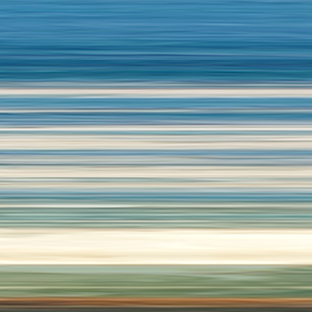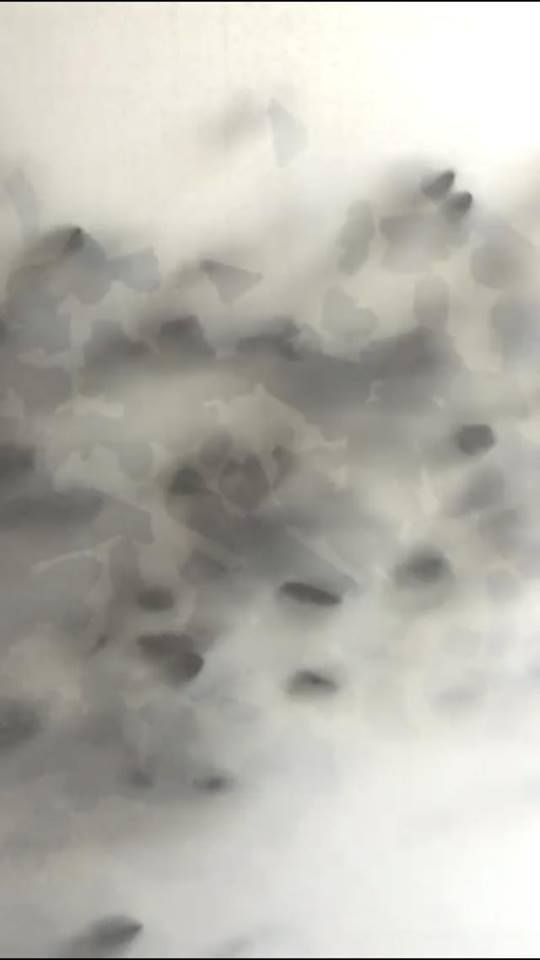If I had to say where I come from, I would say from Lascaux. The memory of human history flows in my genes, a society which has been transhumant from the beginning, tireless traveller in search of a place to settle, but ready to conquer the universe…
A man walked to ‘make way’, creating pathways, indicating to his fellowman the best step. Romans improved roads with their stone walkways; I imagine the sound of legions approaching along those paths, thunderous, invading, protecting… Evolution by means of locomotion opened new roads and ways of travelling, faster, in which perhaps we have only lost attention to our surroundings, as I indicated at the beginning of this exhibition. Le Breton tells us that the car driver is the man of oblivion; it is true that in my travels I do not remember everything, but there are always elements standing out over others whether they are architectural, vegetal, animal, clouds playing in the sky… and that is when colours flood through my eyes, and give shape to this project.
Just as our way of travelling has evolved throughout history, travelling notebooks have moved from paper to mobile devices (at least in my case). I no longer draw on my notebook, I take photographs from the environment, I mark my ‘I was here’ with that memory, my readings have gone from paper annotations to capturing that phrase with my camera, some end up being used in social networks while others simply remain as a file. Those same social networks give me access to other users who provide useful information for my projects, as you can observe. Therefore, the final decision in the elaboration of this travelling notebook ends up having this shape. I hope you enjoy this trip, as much as I do in each of my travels.
Antonio Navarro
Si tuviera de decir de dónde vengo diría que de Lascaux, y en mis genes fluye la memoria de la historia de humanidad, una sociedad que ha sido trashumante desde sus orígenes, viajero incansable en busca de un lugar donde asentarse, pero dispuesto a conquistar el universo…
El hombre caminaba para hacer camino[1], senderos por los que indicar a sus congéneres cuál es el mejor paso. Los romanos mejoraron los trazados con sus calzadas de piedra, imagino el sonido de las legiones acercándose por esas sendas y lo siento atronador, invasor, protector… La evolución en los medios de locomoción abrieron nuevos caminos y maneras de viajar, más veloces, en los cuales tal vez, solo tal vez, hemos ido perdiendo la atención a lo que nos rodea, como indico en el inicio de esta exposición; Le Breton nos dice que el conductor de automóvil es el hombre del olvido[2], en mis viajes es cierto que no recuerdo todo, pero siempre hay elementos que destacan sobre los demás, ya sean arquitectónicos, vegetales, animales, el juego de las nubes en el cielo… y es donde la retina se me inunda de colores que terminan dando forma a este proyecto.
Del mismo modo que nuestra manera de viajar ha evolucionado a lo largo de la historia, el cuaderno viajero ha pasado del papel al dispositivo móvil (por lo menos en mi caso), ya no dibujo sobre el cuaderno, fotografío el entorno, remarco mi “yo estuve aquí” con ese recuerdo, mis lecturas han pasado de anotaciones en papel a capturar esa frase con la cámara fotográfica, algunas terminan siendo usadas en mis redes sociales otras simplemente quedan como archivo. Estas redes sociales me dan acceso a otros usuarios que a su vez me aportan información útil para mis proyectos, como ustedes pueden observar. Por tanto la decisión final en la elaboración de este cuaderno viajero termina teniendo esta forma, espero que disfruten del viaje, tanto como yo lo hago en cada uno de mis desplazamientos.
Antonio Navarro
[1] Caminante no hay camino se hace camino al andar. Antonio Machado.
Extracto de Proverbios y cantares (XXIX)
[2] Le Breton, David. Elogio de Caminar. Biblioteca de ensayo Siruela. 2015
Traducción David Fraser&Miguel Gámez Cuevas





